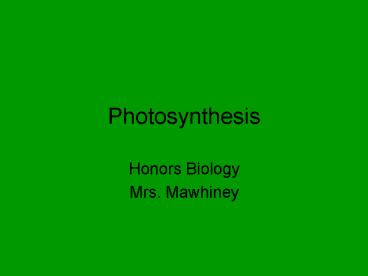Photosynthesis PowerPoint PPT Presentation
1 / 23
Title: Photosynthesis
1
Photosynthesis
- Honors Biology
- Mrs. Mawhiney
2
Objectives
- Explain the importance of photosynthesis.
- Write and interpret the chemical equation for
photosynthesis.
Check Your Understanding How are plant cells
different from animal cells? In what organelle
does photosynthesis take place?
3
All Energy on Earth comes from the Sun!!
4
Light Energy Harvested by Plants Other
Photosynthetic Autotrophs
6 CO2 6 H2O light energy ? C6H12O6 6 O2
5
THE BASICS OF PHOTOSYNTHESIS
- Almost all plants are photosynthetic autotrophs,
as are some bacteria and protists
- Autotrophs generate their own organic matter
through photosynthesis - Sunlight energy is transformed to energy stored
in the form of chemical bonds
(c) Euglena
(d) Cyanobacteria
(b) Kelp
- (a) Mosses, ferns, and
- flowering plants
6
Food Chain
7
Overview
- Carbon dioxide and water are taken in by plants
- Plants absorb light energy and convert it to a
usable form. - ATP
- Energy is used to fix carbon dioxide into sugar
molecules - Chemical energy
- Sugar is converted to starch and stored for use
by the plant, and by animals when they eat plants.
8
WHY ARE PLANTS GREEN?
It's not that easy bein' green Having to spend
each day the color of the leaves When I think it
could be nicer being red or yellow or gold Or
something much more colorful like
that Kermit the Frog
9
Electromagnetic Spectrum and Visible Light
Gammarays
Infrared Microwaves
X-rays
UV
Radio waves
Visible light
Wavelength (nm)
10
WHY ARE PLANTS GREEN?
Different wavelengths of visible light are seen
by the human eye as different colors.
Gammarays
Micro-waves
Radio waves
X-rays
UV
Infrared
Visible light
Wavelength (nm)
11
The feathers of male cardinals are loaded with
carotenoid pigments. These pigments absorb some
wavelengths of light and reflect others.
Reflected light
Sunlight minus absorbed wavelengths or colors
equals the apparent color of an object.
12
Why are plants green?
Reflected light
Transmitted light
13
WHY ARE PLANTS GREEN?
Plant Cells have Green Chloroplasts
The thylakoid membrane of the chloroplast is
impregnated with photosynthetic pigments (i.e.,
chlorophylls, carotenoids).
14
THE COLOR OF LIGHT SEEN IS THE COLOR NOT ABSORBED
- Chloroplasts absorb light energy and convert ito
chemical energy
Reflected light
Light
Absorbed light
Transmitted light
Chloroplast
15
Chloroplasts
- Have TWO membranes
- A bi-bilayer!
- The inner membrane is called the thylakoid.
- The thylakoid is folded and looks like stacks of
coins called granum (grana singular). - The stroma is the space surrounding the granum
Image source http//www.daviddarling.info/encycl
opedia/C/chloroplasts.html
16
Chloroplasts Sites of Photosynthesis
- Photosynthesis
- Occurs in chloroplasts, organelles in certain
plants - All green plant parts have chloroplasts and carry
out photosynthesis - The leaves have the most chloroplasts
- The green color comes from chlorophyll in the
chloroplasts - The pigments absorb light energy
17
Photosynthesis occurs in chloroplasts
- In most plants, photosynthesis occurs primarily
in the leaves, in the chloroplasts - A chloroplast contains
- stroma, a fluid
- grana, stacks of thylakoids
- The thylakoids contain chlorophyll
- Chlorophyll is the green pigment that captures
light for photosynthesis
18
- The location and structure of chloroplasts
Chloroplast
LEAF CROSS SECTION
MESOPHYLL CELL
LEAF
Mesophyll
Intermembrane space
CHLOROPLAST
Outer membrane
Granum
Innermembrane
Stroma
Grana
Thylakoidcompartment
Stroma
Thylakoid
19
Chloroplast Pigments
- Chloroplasts contain several pigments
- Chlorophyll a
- Chlorophyll b
- Carotenoids
Figure 7.7
20
Plants produce O2 gas by splitting H2O
- The O2 liberated by photosynthesis is made from
the oxygen in water (H and e-)
21
AN OVERVIEW OF PHOTOSYNTHESIS
- Photosynthesis is the process by which
autotrophic organisms use light energy to make
sugar and oxygen gas from carbon dioxide and
water
Carbondioxide
Water
Glucose
Oxygengas
PHOTOSYNTHESIS
22
- A Photosynthesis Road Map
Chloroplast
Light
Stroma
NADP?
Stack of thylakoids
ADP P
Light reactions
Calvin cycle
Sugar used for
? Cellular respiration
? Cellulose
? Starch
? Other organic compounds
23
Review Photosynthesis uses light energy to make
food molecules
- A summary of the chemical processes of
photosynthesis
Chloroplast
Light
Photosystem IIElectron transport chains
Photosystem I
CALVIN CYCLE
Stroma
Electrons
Cellular respiration
Cellulose
Starch
Other organic compounds
LIGHT REACTIONS
CALVIN CYCLE

